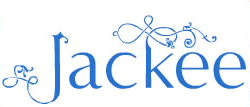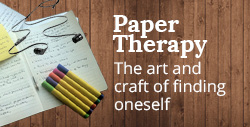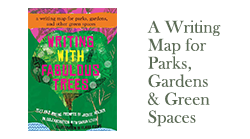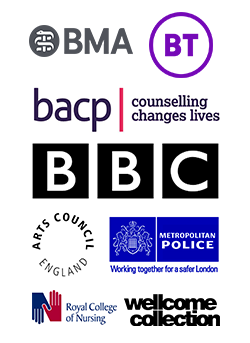Writing
Saturday, December 14th, 2013
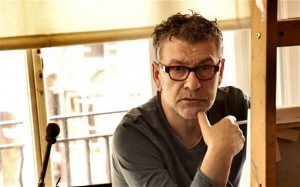
Last weekend I was in Glasgow as part of a 50th birthday celebration with family when as part of our weekend itinerary we went to an exhibition of paintings by Jack Vettriano at the Kelvingrove Art Gallery in Glasgow.
I must admit his name was not familiar to me and I was simply going with the flow. But when I walked into the gallery and caught sight of the first set of paintings I instantly realised I was familiar with his paintings and somehow they had made their way into my psyche whether through a news clip or visual memory the image of the butler and maid standing on the beach holding an umbrella over a couple dancing was not new but already embedded. In fact the painting buried somewhere deep in my psyche was Jack Vettriano famous painting the Singing Butler that sold at Sotheby’s for £750,000.
I had arrived early to the exhibition before my family opting to take a taxi and therefore go at a more leisurely pace so I wandered around the exhibition for a few moments not sure where to start. There was lots of text accompanying many of the paintings and plenty of video clips and short films. It was not long before Vetttriano’s voice bellowing through the television screen of one video drew me in and I sat for ten minutes captivated by this stranger’s story and journey as a painter.
His story is fascinating.
- He left school at 16 to become an engineer but a girlfriend gave him a set of colour paints for his 21st, which saw the beginning of his life as a painter and artist.
- He didn’t go to university saying on camera that he felt had he gone on to do a fine Arts degree he would have been hemmed in and told what and how to draw and paint from someone else’s perspective. Instead he set about and over a number of years taught himself to paint. I could really identify with this as having completed a Masters in Creative Writing and Personal Development I left that course unsure and lacking confidence in my ability to ever publish a book again.
- He changed his surname so not to be confused with his earlier career. Now that got me thinking!
- He struck lucky (note not without having drawn and painted for many years prior) when his first two painting submitted to the Royal Scottish Academy in 1989 sold and that marked the beginning of his career as an artist.
- What became clear as I absorbed his many paintings in this exhibit is that Vettriano is a prolific painter. Here was a live example of what Pam Slim writes about in her latest book, Body Of Work: Finding The Thread That Ties Your Story Together of concrete evidence of what it means to generate a body of work.
- His body of work included video clips and short films; there was plenty of text also documenting the history and the story of both the paintings and the painter. The gift shop was a shrine to high quality products and merchandise all branded with Vettriano’s work including what appeared to be a silk-screen print design umbrella with the choice of images of two of Vettriano’s most famous paintings.
What I admired about Vettriano was his ability to create and generate on different platforms. Not only did he think and speak in images his body of work also includes the spoken word and the written word. There are so many different platforms and mediums for us to communicate and share the body of our work with.
Only this week I came across an Installation at the South Bank Centre in London entitled Coat Tails by Bernadette Russell:
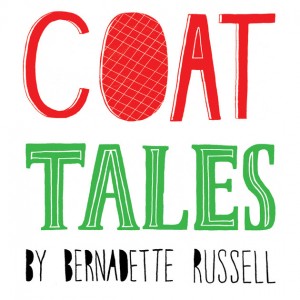
“An installation of donated coats with a twist: each donor write a letter to the person who is to receive the coat and leaves it in the pocket.” This is both art, creativity, writing ………
Writers are no longer confined to just the space on the blank page. Our platforms have grown, have multiplied and are growing more and more by the day.
Technology when interacted with creatively can be the friend of the artist, the entrepreneur, the academic, the person in business and the person on the shop floor. It has potential for everyone, which is about creation rather than deadening. Alas many of us have chosen to be become slaves to technology with little connection to how it can and does breathe life into our worlds and our work. Okay I may be going a bit off point here so back to Vettriano.
His body of work inspired me last weekend. I’ve always been keen to collect quotes and information from other genre’s outside of the areas I tend to work in which is coaching, leadership, management and personal development. Now I can see how slowly every thing is becoming so connected. Science with spirituality, neuroscience with everyday thinking etc.
Just today as I was putting the finishing touches to an e-book I realized that there are so many possible ways I can take this to print that makes what I have written an interactive message rather than one that is static on the page. People want connection and writers want to connect so when we extend beyond our preferred mode of communicating we widen that possibility.
So no longer am I primarily the writer on the page, I am the face on the video, the voice on the interview, the creator of spaces for inspired learning, the weaver of rituals and ceremony on workshops and retreats. These are some of the ways that your own body of work comes to life or has life breathed into it.
I hope you will take time to consider what your body of work will be in 2014. Perhaps Pam Slim’s new book will do the trick for you or someone you know. I’ve worked with Pam in the past and I know that whatever Pam is behind is the real deal. Click here to pre-order Pam’s new book:
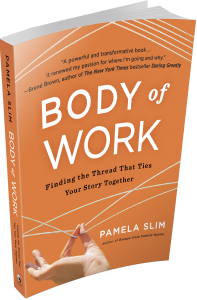
Make time over the Xmas period to plan and vision what your body of work will consist of for the New Year.
Don’t worry about whether it’s been done before, no one will do it the way you do it.
Each of us have our own story to tell and by generating a body of work you tell your story.
I’ll have some goodies to support you with the year ahead in the next week or so.
No Comments
Tuesday, December 3rd, 2013
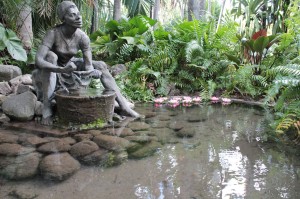
credit: iamajamaican Hope Gardens Kingston
This week’s blog post is from Sonia Henry. Sonia is a former local government manager, life coach, mentor and personal development trainer. She left the UK in 2012 to live in Jamaica. She is enjoying her transition by connecting with nature through her love of writing and gardening. She spend’ her spare time connecting with the local community of Falmouth Trelawny, doing charitable work through Kiwanis International. She is currently working on her first book, The Inner Garden, Life Lessons in Personal Development. In today’s post she pauses to reflect on her writing and her relationship with the *Muse.
* The Eight Muses are the eight Greek Goddesses devoted to the arts: Goddesses of music, song, dance, poetry, knowledge, astronomy and comedy.
One of my last encounters just before I left the UK to fulfill my dream of living in sunny Jamaica was a coaching and mentoring sessions at The British Library in central London with Jackee Holder. It’s hard to believe but in that coaching session we discussed my desire to live and work in Jamaica now, here I am all the way in Jamaica still being inspired by her through the various forms of new technology. In this blog post I want to talk about the mysterious muse?
I was first introduced to the concept of the ‘Muse’ as a writing exercise many years ago when I regularly attended Jackee Holders’ Moon wRites creative writing group which she held on a weekday closest to the full moon each month. Those early days of writing were foundation years in terms of developing my writing practice. The concept of the muse was welcoming to my soul and I have worked with the idea of the Muse since then.
My ambition is to become a published author. I remained quietly excited despite having received an episode of negative feedback from one person who did not realize that they had just shattered my dream by their flippantly negative response to an early but prized piece of work I had asked her advice on. Writer’s block showed up on many occasions when I recalled this incident and the page was left blank.
Since my baptism into the metaphorical world of the muse, I’ve created many books in the pages of my mind; exceptional, creative and powerful words trying desperately to reach the page. This is my own definition of the Muse according to my own personal experience of her presence. The definition came to me as part of an early morning writing exercise:
A mystical form of unconscious trance state that manifests in a split second of time. The muse meets me quietly and seductively bringing my internal battle between my long time friends’ resistance and discipline to a peaceful resolution. My writing angels appear in many forms, signs, and wonders. It amazes me to be an observer of myself as the first word appears on the page and I sink mercifully into the arms of my mysterious muse. As the symbols of language start to appear, I slumber into free writing. Even more powerful for me are the moments when I write morning pages from a newly awakened state of dream awareness. My thoughts then float onto the page like ghosts of the night manifested as words onto the page. They are now a reality that the Muse wants me to share.
As a life coach and trainer, I know the importance of looking back at our childhood passions to realize what we truly enjoy in life. Writing has always been an important part of my life. My journals sit patiently in my yet to be unpacked moving boxes constantly reminding me that there is a writer also waiting to be unpacked.
No Comments
Wednesday, November 13th, 2013
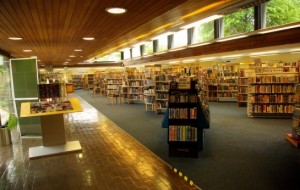
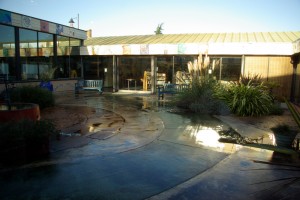
Sitting in my local library this morning I tweeted a quote that came to me as I flittered between working on a writing project and checking my email, “All libraries have potential to be sacred spaces when they harness and allow space, both physical and mental to be silent.” I was caught in a moment of mindfulness as I appreciated the quiet space I was sat in that was allowing me to create.
I feel strongly about protecting silent spaces in libraries, as more and more libraries become community spaces that are noise factories rather than spaces where people can sit back and allow their imaginations to unfold.
Thinking about posting the above quote I decided to google and find images of the library in South London I grew up with to add to the quote so I could post it on my blog. West Norwood library (the library I grew up with) was an iconic library building designed by Ted Hollamby and engineer /architect Edmund Happold and was opened by Princess Margaret in 1969 in the South London suburb of West Norwood.
It was a striking building decked with natural wood and plain white walls primarily influenced by architect Edmund Happold who started his career with Finnish architect Alvar Aalto and Ted Hollamby who was sympathetic to the work and styles of William Morris.
Here are some photo’s I discovered on the Internet showing what the library looked like in its prime.
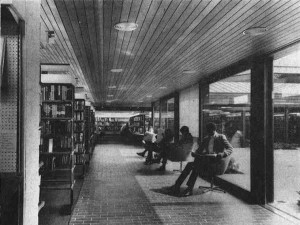
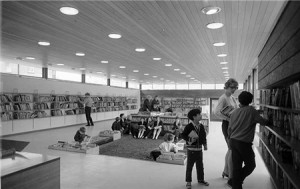
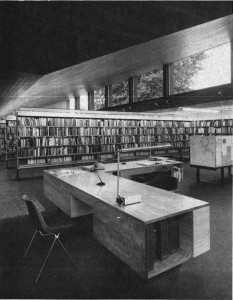
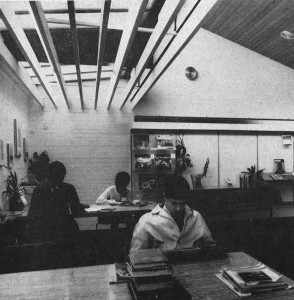
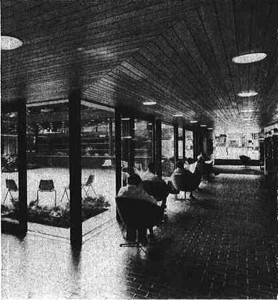
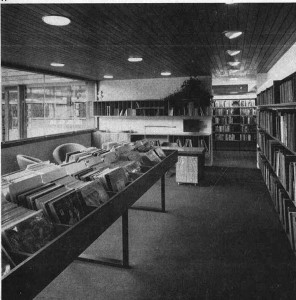
It had a central courtyard around which the library was built. It was adorned with dark brown, polished; slate marble tiles and was completely wheel chair accessible. Its foyer had glass-fronted wall to ceiling cabinets with brilliant lighting that held displays and other exhibitions over the years. One year near when the library had just opened I entered a poem and won second prize and had my poem proudly displayed there.
The children’s library at the front had a pit in the centre, completely child friendly with books built into walnut wood boxes surrounded with a deep ruby red shag pile carpet, which hugged you the minute your feet landed there.
By the time the library opened I was aged seven and jumped straight to the junior section where I recall my first sets of book were the Famous Five books by Enid Blyton. My primary school teacher would read us a chapter from different books in the series at the end of each school day.
No matter how robust and energetic we had been during the day reading time signaled time to get quiet, to settle down and to go inwards as we were captivated by the strong, rhythmic tones of Mrs. Hinds reading voice which would send half of the class to sleep as it was so relaxing and soothing.
The beaches and messy rambling home George (really Georgina), Julian and the rest of the gang hung out in the holidays came alive in my imagination. Here without any persuasion was my first love affair with books.
One Friday afternoon after leaving us on a cliffhanger I could not bear to wait the weekend for the next installment so I begged Mum to let me escape to the library and I raced the ten minutes as if my life depended on it so I could get a copy and read to what came next.
I recall describing the story to the librarian and the two of us flicking through the whole series of Famous Five books trying to find the right story my teacher had read. It was my first memory of real anxiety bittersweet as it was also that moment when books became my best friend and since then have always been.
Over the years I’ve had my fair share of disasters with in person friendships but books have always remained steadfast, reliable and loyal companions. I never feel alone as long as a book is to hand.
So it has been with great disappointment earlier this year when I discovered the library of my childhood had been closed (there are plans to reopen on the new site). In my heart it felt a brutal death and severance despite no longer living in the area. This not being enough months later I discover that this iconic building is being turned into a cinema complex thanks to the Picture House company but it’s death is also messy. It’s copper roof been stolen and squatters have moved and the inside of this stunning building now looks like this. My heart bleeds. At one point the building was taken over by squatters. This is the state they left it in.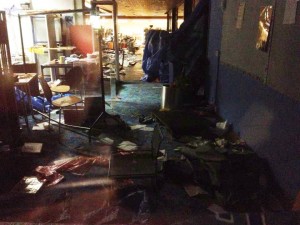
Is this really a way to treat a building that had a wall full of walnut cased cabinets with hand written index cards in fountain pen with references of the names and titles of every book the library ever stocked.
Is this the way to treat a library that fed the hungry souls and spirits of children, teenagers and adults alike? I wonder sometimes where are local authorities heads are at. Libraries feed our souls. Libraries provide us with a place of respite. Books and words wake us up. Does this not require nurturing, a fierce protection? Aren’t libraries, our public libraries a national treasure?
As I wrote on the Face book page for the Friends of West Norwood Library if a new library is incorporated into the site of the new cinema complex I hope it is not turned into some new community style library café where all corners of community converge into open spaces where there are no sanctuaries, no space for a quiet thought, a few minutes or even an hour of solitude for the mind to quiet, for the rage of the world to slow down and for peace to descend.
Is it really necessary to have babies and toddlers screaming in earshot of others trying to study, write a poem or even a love letter or god forbid lose themselves in a book, magazine or some other form of written word? Or is reading and quiet time now an ancient relic and past time of a bygone era?
Perhaps I am forever the optimist or in this case the pessimist. Hoping, wishing and praying that spaces of quiet and reverence will be persevered, protected and much sought after in this world that seems determined to sentence us all to a slow death, poisoned by the onslaught of ever increasing volume of noise and new technology that seems to be the curse of modern day life.
I hope not. But I fear for the worse. We are already in the midst of the typhoon of destruction, as noise becomes the new quiet. I’d love to know your stories and personal memories of libraries that are still sanctuaries of silence?
No Comments
Monday, November 11th, 2013
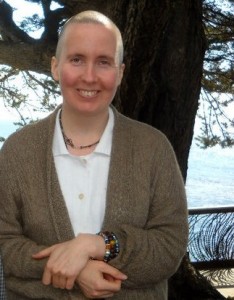
Our guest blog post today is from Zen teacher and practitioner Ji Hyang Padma who currently serves as Director of Spirituality and Education Programs and as Buddhist chaplain at Wellesley College whom I met and worked with a few years ago whilst on a sabbatical retreat at Omega Institute in Upstate New York.
Her new book Living The Season: Zen Practices For Transformative Times launches today and is available from http://www.natural-wisdom.org/livingtheseason.php
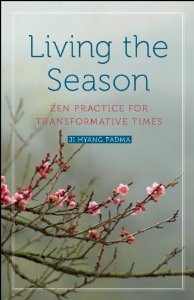
It’s a gentle guide of meditations and collection of Zen wisdoms for slowing down and transforming our lives. Her words and writing are poetic.
We invited Ji Hyang to write about the connection between writing and mindfulness for today’s blog post. Enjoy.
After a day walking in the woods, a day at the writing desk. The autumn winds stir an inner restlessness. There are moments to sit and perceive restlessness; this is a powerful meditation, in which we come face to face with our own low tolerance for discomfort. In other moments, restlessness conveys a message: Take action. Write.
I see the work of writing, as seeing clearly so that one is transformed in the seeing, and then transmitting that moment to others. Words have great potential energy, the energy that changes personal and political realities. The key is to pay attention.
I have loved writing since learning to read, puzzling out the words in the New York Times. I remember rummaging through my parents’ stacks of college books, finding Bury My Heart at Wounded Knee, and sitting down to read that—and the shock and grief which ensued. I felt a strong calling to look into the roots of these issues: what is the underlying pattern, and what can we do to relieve this suffering?
I am still restless to get at the underlying causes and conditions that shape our personal and collective realities. For this reason, I travelled to Cambodia in 1998 just before the elections, with the “Dalai Lama of Cambodia”, Maha Ghosananda, and accompanied him to South Africa, in 1999. These journeys have brought home for me a deep sense of the natural movement between contemplation and action. The proper function of prajna (wisdom) is upaya, compassionate and skillful action. Right now my activism is taking the form of counseling young women, helping them to trust their own deepest experience, to bring the mind into the heart, to see themselves and their lives with eyes of wholeness—and to see each other with clear eyes and open heart.
Writing, counseling and meditation are all practices of paying attention: when we see clearly we change, what we touch with our writing also is transformed. In these practices of departure and arrival, I am a seasoned traveller.
No Comments
Friday, October 25th, 2013
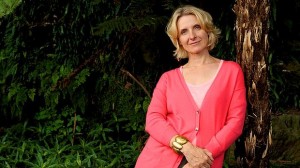
I really enjoy spending time going to talks to listen to my favourite authors talk about their new books and inevitably their writing process.
On Wednesday evening of this week I was not disappointed when I attended the event at the Hatchards Bloomsbury Book Club event with author Elizabeth Gilbert.
To many people Gilbert is the now very famous author of the book Eat, Pray, Love featured on the Oprah Book Club and made into a best selling film starring Julia Roberts.
Listening to Gilbert’s talk I was reminded on so many levels that no best selling author is ever an overnight success.
Gilbert cut her teeth working and writing for magazines like GQ and writing fiction and non-fiction books, which did not all, do well before the phenomenal success of Eat, Pray, Love.
Listening to authors sharing their writing journey is always a humble reminder to keep going and that sometimes success is a long way down the road. Not all of your books will sell, some may go out of print, be remained but your job is to keep on writing and to keep on creating. We must be prepared to create a body of work. Nothing we write is ever wasted.
I keep reminding myself that the repetitive action of writing one word after the other whether in my journal or notebook is taking me somewhere. Of course we cannot always see the destination or where we will arrive. But then again wouldn’t that make life simply so predictable.
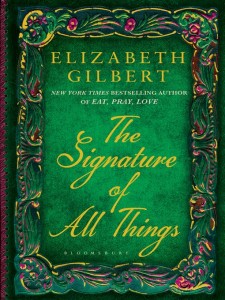 Gilbert’s new book, The Signature of All Things is a chunky, whopper of a book. I’m drawn to the subject matter of botany. There were some great questions from the audience, which included the question of whether she had purposely chosen the name of Alma her main character because of the meaning associated with the name? Turns out she had. In many traditions the name Alma means ‘Soul’ or ‘Spirit’. I test this out by looking up the name Alma in the reference section of my local library and this is what I found, “
Gilbert’s new book, The Signature of All Things is a chunky, whopper of a book. I’m drawn to the subject matter of botany. There were some great questions from the audience, which included the question of whether she had purposely chosen the name of Alma her main character because of the meaning associated with the name? Turns out she had. In many traditions the name Alma means ‘Soul’ or ‘Spirit’. I test this out by looking up the name Alma in the reference section of my local library and this is what I found, “
Gilbert shared how she writes and plots meticulously on index cards, which she stores in five shoeboxes. She loves the fact these are portable and she can move them around.
I’m fanatical about index cards. If I run out I am scheming how to get to the nearest W.H.Smith stationers to restock. Over the years I’ve collected literally hundreds of writing and creativity quotes all recorded on index cards.
For my writing and blog posts I source quotes from a range of places feeling no sense of allegiance as to where quotes come from. So a quote acquired whilst reading a British Airways in house travel magazine on a flight can be as illuminating as a quote acquired from a newly acclaimed book. My motto never assume where a great quote can be sourced.
I learnt the hard way when writing my last book 49 Ways To Write Yourself Well to make sure I record the full reference of where quotes originated from as many a great quote did not make it into my last book because in my excitement and haste I neglected over the years to cite some of the sources of where the quote originated from.
I too have taken to writing first and second drafts on index cards. Because of its size an index card feels less intimidating than a blank sheet of paper and the computer screen.
Gilbert shared some other gems about her writing process including:
- A wise reminder to women writers who made up the majority of the audience that men are not put off sharing half finished products or ill-informed ideas, which brought about a chuckle from the audience. 90 per cent good is good enough is to put our work out there.
- She has 6 years of rejection letters. This is a fact that can be easily overlooked and forgotten about in the haze of publicity surrounding the press and publicity and ultimate success of Eat, Pray, Love.
- She always writes to one reader. She believes this helps her writing voice stay intellectually sound.
- In the beginning of her early writing career she did not help herself enough as an up and coming writer. She made the audience chuckle as she described how in those early days she would just stare at a blank page hoping the words would miraculously appear. This she reminded us is a futile act. Gilbert suggests that the more prepared you can be the more you’ll help yourself along the way. This means have writing prompts to use as a springboard onto the page. Read other writers on writing and try out some of the suggested writing exercises and activities. Don’t just hope, instead act.
- Once you start writing, creativity is like a scavenger hunt, you uncover all kinds of things.
- Gilbert wrote The Signature Of All Things in four months. She did extensive plotting on her index cards and then once she got going she described the writing process like riding a bicycle down hill. I had the world at my fingertips without walking. She felt she had to write fast so she did not lose her nerve.
- On the topic of inspiration Gilbert shared that this is something that she cannot rely on. She described inspiration as the difference between infatuation and a forty-year-old marriage. Our job as writers is to show up no matter how we feel or what our emotional weather map.
- As in the words of Gilbert, “Many oysters before you get to the pearls. But getting to the pearls is really worth it.”
It was a lovely evening and I actually got to say hello to Gilbert and introduced her to the lovely woman sitting next to me, Sarah who had travelled all the way from Doncaster just to hear Elizabeth talk. Sarah even has the words Eat, Pray, Love tattooed on her arm in Sanskrit.
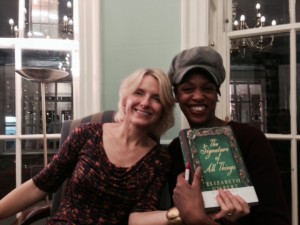
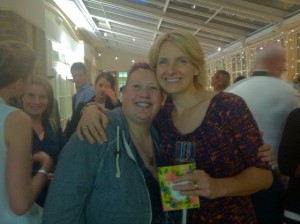
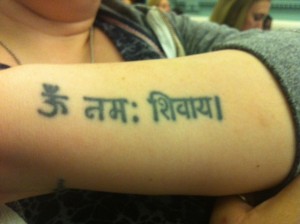
I walked out into the warm October evening air feeling uplifted and encouraged to continue with the writing journey and to support others with their books, writing and creativity.
1 Comment
Monday, October 21st, 2013
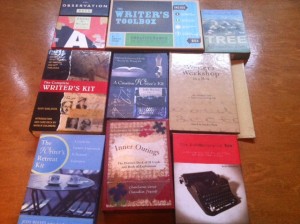
Over the years I’ve really enjoyed working with different writing kits and card decks that I’ve used on a variety of workshops, courses and retreats. This has grown into a collection of card decks and kits that are focused on writing, coaching and self-development. I also have some card decks in my collection, which introduces the different energy’s of the trees we live with, which I’ve posted on my tree blog.
Card deck and kits are a great way of stimulating and engaging learning on workshops and retreats. I’ve never had a participant whose been disappointed when I’ve introduced card decks and kits onto our programmes, in fact the opposite, these resources have always been welcomed.
I also use them as part of my coaching tool kit when working in one to one coaching sessions. They can be a really helpful tool for getting unblocked or for finding a new way in or a different perspective around an issue that is being explored. Some of the decks can be used as a prompt at the start of the session as a form of free association to see what connections there might be to the card, word or image that has been selected.
In the early days when I used kits and card decks a lot more many people would express their resistance to using the cards thinking that they were tarot cards mainly because tarot cards are presented in similar packaging and design it was easy to see why this assumption was made. I always take care and time in explaining that these are different from tarot cards although those with the names Oracle in the title might be more closely aligned to the tarot card decks. I always offer using or working with any card deck or kit as an option.
For those of us who are either visual or more kinasethic learners a card deck or kit can be more stimulating and motivation for learning and reflecting.
Card decks can quickly go out of print and circulation so it’s good to catch them when you can. I’ve grown my collection over 10 years with a vast majority of my card decks coming from Hay House. However I have stumbled over a couple in second handbook bookshops and charity shops including a Tree Oracle Kit and Phases Of The Moon Kit.
I’ve listed below the title of the writing kits and card decks featured above starting from top left to right:
The Observation Deck Naomi Epel, The Writer’s ToolBox Jamie Cat Callan, Tree Affirmation Cards Victoria Sofia Lewis (I snuck that one in), The Complete Writer’s Kit Scott Edelstein, A Creative Writer’s Kit Judy Reeves, The Writer’s Workshop In A Box edited by Sandra Bark, The Writer’s Retreat Kit Judy Reeves, Inner Outings Charlene Geiss & Claudia Jessup & The Autobiography Box Brian Bouldrey.
Here’s a list of the self-development & coaching card decks and kits starting from top left to right:
Labyrinth Wisdom Cards Tony Christie, Archetype Cards Caroline Myss, The Letting Go Cards Melodie Beattie, Best Year Of Your Life Debbie Ford, Tips For Daily Living Iyanla Vanzant, Wisdom For Healing Cards Caroline Myss, The iFactor Cards Ken Barnes, Goddess Guidance Oracle cards Doreen Virtue The Healing Cards Caroline Myss, Karma Coaching Cards, Coaching Cards For Relationships, Coaching Cards For Business Owners, Coaching cards for Everyday Use, Coaching Cards For & Coaching Cards For Managers (coaching cards all available from http://www.barefootcoaching.co.uk/category/catalog/Coaching%20Products), Soul Coaching Oracle Cards Denise Linn, Self Care Cards Cheryl Richardson, The Spa Deck Barbara Close & Susie Kushner, The Healing Deck Monte Farber & Amy Zerner, The Daily Affirmation Cards Cheryl Richardson & The Grace Cards Cheryl Richardson.
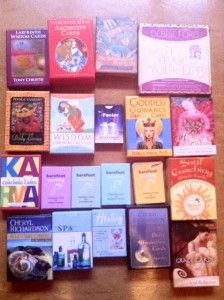
No Comments
Sunday, October 13th, 2013
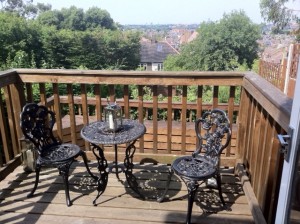
Our final guest post is from psychotherapist and coach Chrystelle Heldire
I wrote this piece when during the Writing Retreat review day. We had group work and individual time to write in a beautiful environment. During one exercise I was not sure what to write about so I looked around and got in touch with how I felt about the garden I was in. I decided to write about it.
The Garden
The garden caught my eyes. It is a 3-part stepped garden. Three parts like the Freudian theory of personality, or Berne’s Transactional Analysis. It is not what I want to write about really, I am only mentioning this because I am a psychotherapist and I identify strongly with my profession. In fact I identify with some many parts of me like my Guadeloupian heritage, being born a Parisian, being a Londoner and Essexisonian, being a woman, being Black, being in my 40s although that is a little wobbly, being a writer…
Anyhow, I just transgressed… Let’s go back to the garden.
It is a beautiful garden. Kind of a dream garden. A garden where dreams can happen, and a garden that was obviously a dream. The garden has a motherly feel. Not maternal as maternal is like a function. Motherly is like an attitude and a promise.
I imagine this garden has much wisdom, much knowledge and many secrets. I like the wooden deck I am sitting on. It has two chairs and a metal table that screams intimacy. The wood is inviting and although I can imagine how may great parties have been or could be hosted here, it seems to have a more humble raison d’être. Maybe it has even waited for me all this time and in its homage, here I am writing about the garden.
There is a middle part, introduced by a path made of concrete slabs leading to brick stairs. This part hides itself behind the wooden sister bench and uses it shoulders to lean against a beautiful climbing passionflower plant. And passionate if you wanted to be you could, as it has managed to keep an air of privacy although belonging to the capital. I can only imagine the beautiful summer days being the expression of one’s freedom in topless bikini and the winter days being shelter for the strong and resilient. It is fascinating what a space can do.
The third and subjacent part is more modest and dressed in black as if for a funeral. That could be because the apple tree suddenly died and all around is mourning. Or it could be that this part has not yet evolved in what it is supposed to be.
The third part is not necessarily my favourite, unfortunately I am a product of my environment and I too am a victim of the fickleness of beauty. However it is the most interesting for my soul because it tells me of its potential.
The third part is nothing at all and everything that it could be at the same time. It is infinite possibilities and it is also what it is right now, evolving or mourning. Is it an interesting and full of surprises evolving space or is it a covered area with a dead apple tree pregnant with dying apples. In fact it is both.
How interesting that the third part should be the part the demands more of my attention. It’s the most modest, the least functional on this autumn day where the rain has not made up her mind whether to fall or stay in the clouds. Like the third part she is tentative, tells us she is there but does not commit fully. And so, what to say about the garden?
It is a generous garden with its treasure hidden in the bushes. A beautiful garden with its aura of wisdom. A humble garden with its acceptance of where it is. Like the kind of garden which is what it is and does not try too hard. This the way I see it anyway and this is the way it will inspire me for a while.
It could be that I am totally wrong. Maybe the third part has undressed itself to wear its Chanel of garden or maybe… Well actually do I need any maybes? It is what inspires me. I am inspired to embrace all parts of me the modest and the arrogant, the discrete and the loud, the generous and the stingy, the beautiful and the ugly. To the garden I give thanks as it masters the gift of my creative energy.
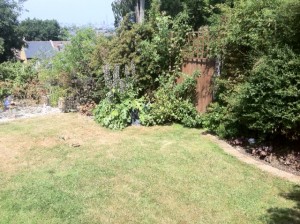
No Comments
Sunday, October 13th, 2013
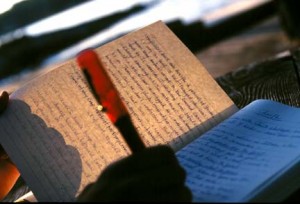
One of the groups’s writing prompts for the day was – The reason why I write? Here is Gilly Workman’s response. Gilly writes a blog @ http://www.angelicmessenger.org.uk/the-journey—my-blog.html
I write in order to connect with the deeper parts of me that otherwise might remain hidden from view; even from myself. It is a powerful yet gentle way in which I give myself the precious gift of time to truly listen to me. The voice that reveals itself in the special space of silence and solitude that I award myself on a regular basis. My heart and soul rejoices when I do this, weeps when I do not. Sometimes it is for release and healing, other times, for dissection and exploration.
I connect with memories, thoughts, feelings and emotions, allowing myself to unite with each and every one as they arise from the depths of the well, which is me.
When I write in my journals, I can immerse myself in the fathomless depths of the pages that open up before me. A landscape that is waiting to be painted, but pens and words are my brushes and pictures. I began with a blank book, now
I am actively filling that time with my voice. It liberates me as no one else will see my journals; I write for my own eyes only so I have the freedom and gift to be completely honest.
Then I also write because I want to be published. And in doing so, I will leave a part of my heart and soul here on the earth plain, for the rest of the world to engage with. I will achieve immortality through my words and musings, my many writing voices that have evolved, spiralling sentences that weave in and out of the many pages. Writing liberates and validates me.
It has allowed me to safely analyse and work with my shadow side and give her expression. I sometimes release my ‘inner bitch’ and she enunciates that which dare not speak its name in real life. My pen transmutes into a rapier sword, cutting into the heart of the villain, releasing the protagonist from her shackles.
But not all of my writing is like this. Some of my short stories are ‘medicine stories’, sacred offerings to others on the altar of life’s tumultuous journey through the landscape of the soul. They become a balm for the soul; both my soul and I hope for other souls too.
They offer hope; the hope that others too can survive life events that threaten to overwhelm the individual and leave them with a detailed map of how to negotiate their way through the labyrinth, avoiding the Minotaur that lurks at the dark and murky centre. A signpost that can and will direct the wandering seeker towards the promised land of inner strength and deep knowing that they too, can survive. And will survive. The sun will shine again and the sky will be blue and cloudless, if we just give ourselves the gift of time to stop and be who we truly are.
Some stories are a celebration of rites of passage, especially the latter rites of passage that takes us women into the crone phase of our lives. It is not something to be feared, even in a western society that values youth, appearance and materialism above experience and wisdom.
My writing says ‘Be who you are and glorify that. For you are unique and show yourself to the world, unashamedly.’ Celebrate your power and uniqueness, be the Mad Woman who dances on the moors, and join me in my flowing skirts and dance.
No Comments
Sunday, October 13th, 2013
Over the next few days I will be sharing a series of guest blog posts. The first will be a selection of writing extracts from the group of writers who attended the Glastonbury Writers Retreat I ran in July of this year.
We gathered two weekend ago at my home in South London for a Writing review day. All the post I will be sharing emerged from one of our many writing prompts we worked with throughout the day.
Enjoy the first of our guest posts from Coach, Facilitator, Management trainer and Three Peaks Walker Lynne Philp.
Morning Pages
Since I first learnt about Morning Pages at the Writing for our Lives Retreat In Glastonbury with Jackee Holder, I have enjoyed writing the occasional morning piece. But, in truth, it has been very occasional. This morning, immediately after yesterday’s “Writing for your Lives” Retreat Review day with Jackee, a bright light was switched on for me – it was one of those moments when something strikes you so hard, that it stays with you forever.
I started to write, slowly……. reflecting on our day at Jackee’s lovely home in London. I was thinking about her beautifully carved table, the stunning photo of Lewis Hamilton and the pretty, coloured lights in the fireplace – all creating a truly, beautiful room. Coincidentally, I was sat in my new lounge, first the first time in months, with my new log fire and gorgeous, wooden floor. Suddenly, my writing started to take on a breath of its own and here’s what emerged:
My fire, my beautiful fire
I’ve been waiting for you for so long
Waiting to see your face
Waiting to feel your warmth,
Wrap around me, keeping me snug,
Keeping me safe.
I’ve been missing you
All of my life
Looking for your glow
Searching for my light
To show me the way
To live my life.
You are coming now
Winter is approaching
Our log store is full
Ready to feed you
Ready to nourish you
You’re ready now
You have your place
In our beautiful room
By my side
Finally, in my life,
My fire, my light.
So, this is the power of morning pages? I have found it now. its about getting you to start to write, to gently wake up your sleeping imagination and creativity. You write and then suddenly, you’re catapulted to a new place, somewhere you’ve never been before. It stretches your mind, first thing in the morning, taking you on a mystery tour before you start your day. Wow!
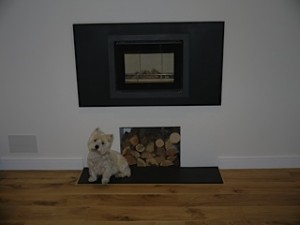
Lynne’s Fire and adorable dog Todd.
No Comments
Thursday, October 10th, 2013
Follow the link below to listen to my interview on Creative Writing and Mindfulness with writer, online host, interviewer and spiritual explorer Eileen Parr.
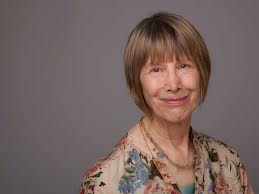 Listen here
Listen here
Jackee Holder Interview with Eileen Parr October 2013
No Comments
